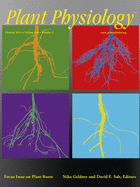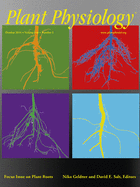
Cover image

On the Cover: The cover image, entitled “The shape of roots to come,“ was composed by Alexander Bucksch from the computed binary image masks of cowpea roots. The image conveys the diversity of root shapes of an emerging crop and the increasingly important algorithmic advances enabled by computational plant sciences. As described in Bucksch et al. (pp. 470–486), computational analysis of root systems excavated and imaged in field conditions enabled the phenotypic differentiation of 188 cowpea genotypes.
Volume 166, Issue 2, October 2014
EDITORIAL - FOCUS ISSUE
Focus on Roots
BREAKTHROUGH TECHNOLOGIES - FOCUS ISSUE
Hairy Root Transformation Using Agrobacterium rhizogenes as a Tool for Exploring Cell Type-Specific Gene Expression and Function Using Tomato as a Model
Testing tomato gene expression with tagged nuclei and ribosomes and CRISPR/Cas9 genome editing shows conservation of SHORT-ROOT gene function.
Image-Based High-Throughput Field Phenotyping of Crop Roots
Automatic methods developed or reproducible field-based phenotyping allow distinction of genotypes, including 13 newly accessible plant root traits.
Visualization of Root Water Uptake: Quantification of Deuterated Water Transport in Roots Using Neutron Radiography and Numerical Modeling
Neutron radiography traces the transport of deuterated water in soil and roots to reconstruct the water flow across the root tissue and along the xylem.
UPDATES - FOCUS ISSUE
Plant Nutrition: Root Transporters on the Move
The dynamics of nutrient transporters and channels emerges as a critical and highly regulated cellular process controlling nutrient uptake and distribution in plant roots.
Root Nutrient Foraging
Root morphological traits that are relevant for nutrient acquisition are regulated by nutrients and the plant’s nutritional status.
Natural Variation of Root Traits: From Development to Nutrient Uptake
Natural variation of root growth informs on processes that govern root development, responses to nutrient availability, and ion uptake and homeostasis.
Radial Transport of Nutrients: The Plant Root as a Polarized Epithelium
Different routes underlie radial transport of nutrients in plant roots and are influenced by the endodermis permeability and the polarity of transporters.
Branching Out in Roots: Uncovering Form, Function, and Regulation
The diversity of postembryonic root forms and their functions add to our understanding of the genes, signals and mechanisms regulating lateral and adventitious root branching in the plant models Arabidopsis and rice.
Beyond the Barrier: Communication in the Root through the Endodermis
The endodermis acts as a barrier to solute and water movement but also has important functions in signaling and morphogenesis.
Strigolactone Involvement in Root Development, Response to Abiotic Stress, and Interactions with the Biotic Soil Environment
Strigolactones play a role in root development, root response to nutrient deficiency, and plant interactions in the rhizosphere.
The Origin and Early Evolution of Roots
Exceptionally well-preserved fossils shed light on the earliest roots and their interactions with the environment.
Functional Soil Microbiome: Belowground Solutions to an Aboveground Problem
The functional soil microbiome is an important parameter in developing a sustainable and effective strategy to increase crop yield and food security.
Biotic Interactions in the Rhizosphere: A Diverse Cooperative Enterprise for Plant Productivity
Roots and microbes secrete organic compounds into the rhizosphere that influence plant productivity.
Perennial Roots to Immortality ,
Roots play a key role in determining long life in perennials.
RESEARCH ARTICLES - FOCUS ISSUE
Low Crown Root Number Enhances Nitrogen Acquisition from Low-Nitrogen Soils in Maize
Low crown root number improves nitrogen acquisition in maize by enhancing deep soil exploration in low-nitrogen soils.
The Optimal Lateral Root Branching Density for Maize Depends on Nitrogen and Phosphorus Availability
The optimal lateral root branching density in the maize root system depends on the relative availability of nitrate (a mobile soil resource) and phosphorus (an immobile soil resource), with the optimum shifting to more branches when the nitrate-to-phosphorus ratio is high.
Origin and Development of the Root Cap in Rice
Cellular and molecular events are inherent to the formation and development of the root cap in rice.
The anthocyanin reduced Tomato Mutant Demonstrates the Role of Flavonols in Tomato Lateral Root and Root Hair Development
Flavonols contribute to lateral root development through the regulation of auxin transport and root hair and they modulate the levels of reactive oxygen species.
The ASH1-RELATED3 SET-Domain Protein Controls Cell Division Competence of the Meristem and the Quiescent Center of the Arabidopsis Primary Root
A histone Lys methyltransferase gene is expressed in the root stem cell niche and contributes to coordinated divisions in the immediate cell lineage originating from the same stem cell.
Abscisic Acid and LATERAL ROOT ORGAN DEFECTIVE/NUMEROUS INFECTIONS AND POLYPHENOLICS Modulate Root Elongation via Reactive Oxygen Species in Medicago truncatula
Both abscisic acid and a nitrate transporter regulate the production of ROS and the expression of superoxide-generating NADPH oxidase enzymes to regulate root elongation.
Duplicate and Conquer: Multiple Homologs of PHOSPHORUS-STARVATION TOLERANCE1 Enhance Phosphorus Acquisition and Sorghum Performance on Low-Phosphorus Soils
Sorghum homologs of a rice gene contributing to P-starvation tolerance enhance P uptake and crop performance in low-P soils via modulation of root system morphology and architecture.
Activity of the Brassinosteroid Transcription Factors BRASSINAZOLE RESISTANT1 and BRASSINOSTEROID INSENSITIVE1-ETHYL METHANESULFONATE-SUPPRESSOR1/BRASSINAZOLE RESISTANT2 Blocks Developmental Reprogramming in Response to Low Phosphate Availability
Pi deprivation shifts the subcellular distribution of two key brassinosteroid-related transcriptional effectors to trigger shallower root system architecture.
Root Cortical Aerenchyma Enhances Nitrogen Acquisition from Low-Nitrogen Soils in Maize
Abundant root cortical aerenchyma improves plant growth under nitrogen-limiting conditions by decreasing root metabolic costs, enhancing soil exploration in deep soil strata, thereby increasing nitrogen acquisition at greater depths.
It’s Complicated: Intraroot System Variability of Respiration and Morphological Traits in Four Deciduous Tree Species
Extended branching order classification describes morphological variability in root systems and respiration better than traditional root diameter classes or root orders alone.
ON THE INSIDE
On the Inside
COMMENTARIES
Glycosylphosphatidylinositol Anchoring: Control through Modification
Glycosylphosphatidylinositol-anchor biosynthesis and glycosylphosphatidylinositol modification of proteins are central to coordinated plant development.
Nicotianamine Secretion for Zinc Excess Tolerance
Root exudation of nicotianamine is required for excess zinc tolerance.
Articles
BIOCHEMISTRY AND METABOLISM
Loss of Cytosolic Phosphoglucose Isomerase Affects Carbohydrate Metabolism in Leaves and Is Essential for Fertility of Arabidopsis
An enzyme of cytosolic hexose phosphate metabolism is essential for plant reproduction and important for photosynthesis.
A Secreted Protein with Plant-Specific Cysteine-Rich Motif Functions as a Mannose-Binding Lectin That Exhibits Antifungal Activity
Ginkbilobin2 is shown to exert antifungal activity through its interaction with a1,2-linked mannose chains of fungal cell wall mannan, which provides clues to the molecular function of the DUF26 protein family.
Ectopic Terpene Synthase Expression Enhances Sesquiterpene Emission in Nicotiana attenuata without Altering Defense or Development of Transgenic Plants or Neighbors
Plants expressing two sesquiterpene synthases emitted increased quantities of target volatiles without changes to other volatiles, defense, growth, or yield in transformants or neighboring plants.
Unraveling the Mechanism Underlying the Glycosylation and Methylation of Anthocyanins in Peach
Diversification of anthocyanins in peach is attributed to glycosylation and methylation.
CELL BIOLOGY
Laccases Direct Lignification in the Discrete Secondary Cell Wall Domains of Protoxylem
The discrete localization of laccases to secondary cell walls directs lignification in protoxylem.
FRIENDLY Regulates Mitochondrial Distribution, Fusion, and Quality Control in Arabidopsis
Disruption of intermitochondrial association affects mitochondrial quality control, leading to mitochondrial stress, cell death, and strong growth defects.
ECOPHYSIOLOGY AND SUSTAINABILITY
Leaf Vein Length per Unit Area Is Not Intrinsically Dependent on Image Magnification: Avoiding Measurement Artifacts for Accuracy and Precision
Measurements of leaf vein length per area do not increase systematically with image magnification, contrary to a recent claim, given appropriate attention toward accuracy and precision.
Root-Secreted Nicotianamine from Arabidopsis halleri Facilitates Zinc Hypertolerance by Regulating Zinc Bioavailability
Root secretion of nicotianamine from zinc-hyperaccumulating Arabidopsis halleri facilitates zinc hypertolerance through coordinating zinc uptake and iron homeostasis in roots.
Increased Ratio of Electron Transport to Net Assimilation Rate Supports Elevated Isoprenoid Emission Rate in Eucalypts under Drought
Volatile isoprenoids emitted by plants, enhanced by photosynthesis under drought, have a significant influence on ozone pollution and global climate.
GENES, DEVELOPMENT AND EVOLUTION
TRANSLOCASE OF THE INNER MEMBRANE9 and 10 Are Essential for Maintaining Mitochondrial Function during Early Embryo Cell and Endosperm Free Nucleus Divisions in Arabidopsis
Two mitochondrial translocases are essential for the division during early embryo and endosperm development in Arabidopsis.
Digital Inventory of Arabidopsis Transcripts Revealed by 61 RNA Sequencing Samples
Analysis of 61 RNA-seq samples reveals the existence of common, rare, and nondetectable transcripts, including ubiquitous transcripts, dominant/subordinate transcripts, and switch transcripts, in terms of their expression and transcript ratio.
ATP-Dependent Binding Cassette Transporter G Family Member 16 Increases Plant Tolerance to Abscisic Acid and Assists in Basal Resistance against Pseudomonas syringae DC3000
An ATP-dependent binding cassette transporter contributes to plant resistance to infection by Pseudomonas syringae and tolerance of abscisic acid.
The VASCULATURE COMPLEXITY AND CONNECTIVITY Gene Encodes a Plant-Specific Protein Required for Embryo Provasculature Development
A plant-specific protein controls the complexity and connectivity of veins in cotyledons.
Genetic Analysis of DEFECTIVE KERNEL1 Loop Function in Three-Dimensional Body Patterning in Physcomitrella patens
A proposed regulatory loop segment of the DEK1 transmembrane domain is required for gametophore patterning in Physcomitrella patens.
MEMBRANES, TRANSPORT AND BIOENERGETICS
Tomato Fruit Chromoplasts Behave as Respiratory Bioenergetic Organelles during Ripening
Tomato fruit chromoplasts exhibit a respiratory process linked to ATP synthesis that uses NAD(P)H as electron donors and represents 25% of total ripe fruit respiration.
Inhibition of Nitrate Transporter 1.1-Controlled Nitrate Uptake Reduces Cadmium Uptake in Arabidopsis
Cadmium inhibits controlled nitrate uptake by roots, but this has the beneficial effect of reducing cadmium entry into roots.
The Role of a Potassium Transporter OsHAK5 in Potassium Acquisition and Transport from Roots to Shoots in Rice at Low Potassium Supply Levels
A high-affinity rice potassium transporter plays a major role in K acquisition by roots faced with low external K and in K upward transport from roots to shoots in K-deficient rice plants.
Voltage-Sensor Transitions of the Inward-Rectifying K+ Channel KAT1 Indicate a Latching Mechanism Biased by Hydration within the Voltage Sensor
Manipulating the electrostatic charge network that stabilizes the voltage sensor of the KAT1 K+ channel displaces channel gating across more than 140 mV within the physiological voltage range.
Dynamics of Carbon-Concentrating Mechanism Induction and Protein Relocalization during the Dark-to-Light Transition in Synchronized Chlamydomonas reinhardtii
In synchronized Chlamydomonas reinhardtii cells, the carbon-concentrating mechanism is induced prior to dawn, which coincides with the relocalization of key proteins to the chloroplast pyrenoid.
SIGNALLING AND RESPONSE
Distinct Signaling Mechanisms in Multiple Developmental Pathways by the SCRAMBLED Receptor of Arabidopsis
A single receptor-like kinase exhibits distinct signaling requirements to mediate different developmental events in Arabidopsis.
Distinct Roles for Mitogen-Activated Protein Kinase Signaling and CALMODULIN-BINDING TRANSCRIPTIONAL ACTIVATOR3 in Regulating the Peak Time and Amplitude of the Plant General Stress Response
Unbiased screening through forward and chemical genetics unveils components distinctly regulating the peak time and amplitude of the plant general stress responses.
Oxidative Stress Contributes to Autophagy Induction in Response to Endoplasmic Reticulum Stress in Chlamydomonas reinhardtii
Alteration of the intracellular redox state during endoplasmic reticulum stress contributes to autophagy activation in Chlamydomonas reinhardtii.
Arabidopsis Triphosphate Tunnel Metalloenzyme2 Is a Negative Regulator of the Salicylic Acid-Mediated Feedback Amplification Loop for Defense Responses
A triphosphate tunnel metalloenzyme is a negative regulator in amplification of SA-dependent defense responses.
Large-Scale Identification of Gibberellin-Related Transcription Factors Defines Group VII ETHYLENE RESPONSE FACTORS as Functional DELLA Partners
Transcription factors of the APETALA2 superfamily are regulated by DELLAs which represents a cross regulatory node for gibberellins and ethylene to control apical hook opening.
SYSTEMS AND SYNTHETIC BIOLOGY
Label-Free Protein Quantification for Plant Golgi Protein Localization and Abundance
A quantitative proteomic approach enables unambiguous protein localization to the plant Golgi apparatus and rank ordering of the Golgi resident proteins by abundance, providing a unique view on the organization of this organelle.


